Steam Deck vs next-gen gaming - is Valve's handheld future-proof?
Ray tracing, UE5 and Flight Sim tested - with some stunning results.
When Digital Foundry reviewed Steam Deck, the overall takeaway was that Valve had delivered by far the most powerful handheld we'd ever seen - to the point where we could take PC ports of console games and run them at PS4-equivalent settings with much the same performance. The only difference? Lowering resolution from 1080p down to 720p or 800p. There's more to Steam Deck, however. Its main processor is based on the same core technologies as the silicon that powers PlayStation 5 and Xbox Series X/S. It's 'next-gen capable' if you like - but does it have the horsepower to run cutting-edge games at reasonable frame-rates?
Ideally, it's a question we should have answered in the main review, but there's a problem: despite running Steam, the Deck is based on Linux rather than Windows, meaning that a wide range of games still don't run, while features such as hardware-accelerated ray tracing are not supported. Essentially, every single game or feature required to test Steam Deck's next-gen credentials has issues: the path-traced Quake 2 RTX or Remedy's Control's RT features cannot be accessed from Linux. Meanwhile, proper next generation experiences such as Microsoft Flight Simulator should be able to run but don't owing to Steam Deck's lack of compatibility with online anti-cheat technologies.
Testing these features is important because it sets the baseline for how future-proof Steam Deck might be. Getting PlayStation 4-level experiences working on a handheld is a stunning achievement but what of the future? Thankfully, there's a solution - Windows drivers are now available for Steam Deck, meaning users can 'opt out' of the Linux experience and install anything they like, opening the door to testing high-end games and hardware-accelerated RT.
To be clear though, I can't recommend Windows for Steam Deck. The user experience is degraded, features like instant suspend/resume don't work, hot-swapping of SD cards isn't supported and of course, a good system-level 30fps cap - essential for prolonged battery life - are not available. Right now, there are no audio drivers either. In time the situation may improve, but right now, it's clear that everything that makes Steam Deck an enjoyable handheld experience comes down to the work Valve did on the Linux side. Still, with Windows installed and Steam up and running, it's possible to put all of the features of the RDNA 2 GPU through their paces. Hardware RT works - and surprisingly well, with caveats.
The first port of call was Metro Exodus: Enhanced Edition, built on a revised version of the 4A Engine which only operates on hardware that supports RT. It boots, it works and it runs well. How well? I decided to match up my results with 4A's Xbox Series S port. 60fps was off the table (we are talking about a four teraflop GPU stacked up against the Deck's 1.6TF equivalent) but 30fps was viable and I was pleasantly surprised to find that a fair amount of content could run at native 720p resolution.
The Series S build of Metro Exodus EE has dynamic resolution scaling where the PC version does not, but I found that using a 0.7 scale (essentially 504p with extra detail injected from prior frames to reach 720p) produced great results on the handheld screen and stabilised most of the poorly performing areas. If the PC version had the same dynamic resolution scaling feature as the consoles, an already brilliant Steam Deck result would look even better and play smoother still.




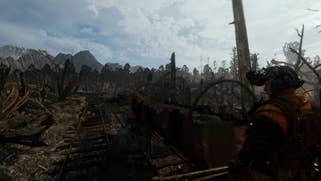
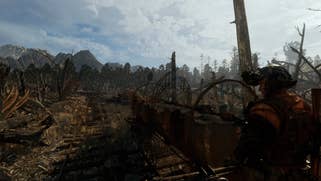


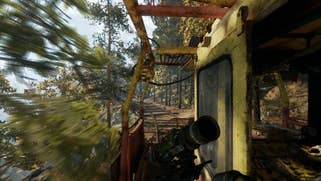



Not so impressive is Control: Ultimate Edition. Yes, the full gamut of RT features is available, and I chose to lock in the Xbox Series X and PS4 options: RT reflections and transparency reflections. To get anything like a playable frame-rate, this required dropping down from 720p to 540p. With performance in the range of 18fps to around 35fps, it's clearly not a playable experience and unlke Metro Exodus Enhanced Edition, Control itself hails from an era where the developers had no access to RDNA 2 technology - which is borne out by Control failing to perform well even with desktop RDNA 2 graphics products from AMD. However, even without RT, Radeon struggles with this game - and it may well be a driver issue as SteamOS runs Control far better than Windows to the point where there's occasionally a 20fps difference at 720p!
I also tested Quake 2 RTX, an altogether more challenging prospect for Steam Deck as this Nvidia port of the original id Software release eschews all forms of traditional rasterisation in favour of path tracing, essentially creating every given frame from tracing rays from various light sources, mapping their bounces off geometry. It's the purest form of RT and also the most computationally expensive. Running at 720p on default settings produced predictably dire results in the region of 12-15fps, while dropping to 432p with temporal upscaling back to 720p brought that up to circa 30fps - sometimes higher, sometimes lower. Path-traced Quake 2 at 60 frames per second? Remarkably, it's possible, albeit at a dynamic resolution of between 216p to 252p. It's not that attractive as you might imagine, but it works - and it's certainly the most playable form of the experience. I guess the takeaway is that again, I was surprised to get playable results from an RT experience running on a 1.6TF GPU that is capped at a mere 15 watts of power.
I also wanted to try the path traced version of Minecraft, but once again fell foul of the Windows Store not working properly (nothing to do with Steam Deck) but thankfully, Microsoft Flight Simulator is also available on Steam, meaning that I could one of the most challenging PC games through its paces on the Valve handheld. I'd seen YouTube videos of this game running reasonably well on its lowest settings, but my objective was to get an experience that could match Xbox Series S's quality settings - a mixture of low, medium and high, along with curtailed object level of detail and terrain level of detail values. Those latter settings can't be matched because Asobo Studio used a dynamic range of between 25 to 50 - so instead, I used a mid-point, 35. I also dropped back the volumetric clouds setting from high to medium, as it's an excessively taxing system. Resolution? Again, I leaned into temporal upscaling, from 612p scaled to 720p. That's up against native 1080p on Xbox Series S.

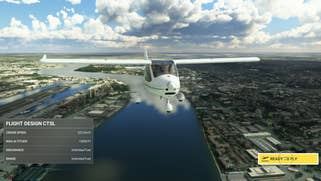


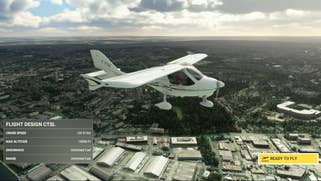
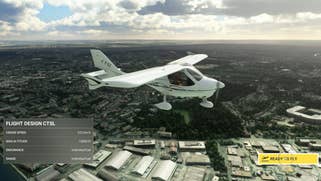
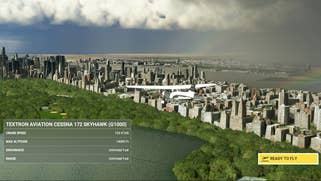


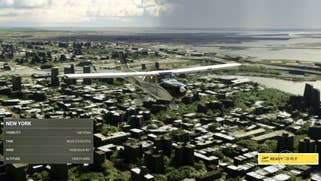

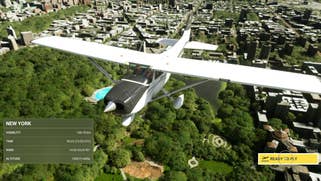
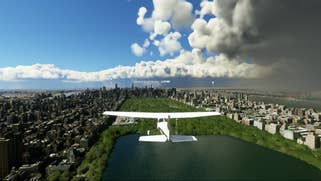

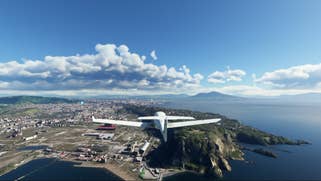



Similar to Metro Exodus Enhanced Edition, Flight Simulator offers up a capped 30fps option that respects consistent 33.3ms frame-pacing. I enabled this, again matching Series S. The end result is quite remarkable: we can retain the density of the experience, draw distances are either a touch better or a little worse than Series S depending on content but the big takeaway is that 30fps is achievable - albeit with caveats. Flying low over super-dense cities, or in areas heavy in trees, or with fast camera movement in the chase-cam view can all cause performance to drop. Thankfully, the nature of the experience ensures that this is hardly a deal-breaker.
At this point, Control ray tracing aside, Steam Deck's next-gen capabilities are looking quite impressive. In the case of Metro Exodus Enhanced Edition and Flight Simulator, we're seeing experiences that compare well against Xbox Series S and look quite astonishing playing out on a handheld screen. It's also heartening that any compromises that we have made are nowhere near as noticeable as they are looking at Switch's various 'impossible' ports. Those games work, but are often impacted by performance problems and blurry resolution - while settings are often lower than PC's low. With Steam Deck, I can run Metro Exodus on medium with normal RT, while Flight Sim is very, very close to the Series S standard.
However, as promising as the results are, there is one exception: Unreal Engine 5. Epic Games is aiming to deliver a new paradigm in rendering, with hitherto unheard of levels of detail, movie CG-quality assets, and a high-end real-time global illumination system. My testing took place before the recent release of the full engine and was restricted to the existing early access demo: Valley of the Ancient. It struggled to maintain 20fps, even with internal resolution at 360p, using UE5's impressive temporal super resolution technology to upscale back to 720p. The CPU burden of UE5 seems to be the primary culprit here - it's extremely taxing in Valley of the Ancient and while optimisations have taken place since the early access UE5 build, hands-on testing of the most recent demo suggests that this is still the primary bottleneck. I've since returned to a SteamOS install on my Deck, but can't imagine that Unreal Engine 5 is any more viable in its current incarnation.
Despite ending on a less optimistic note, experiments in really pushing Steam Deck's features and performance once again results in some truly surprising results - but it's all about picking and choosing your battles for best results, and in this respect, I'm able to tap into much of the work done by my colleagues at Digital Foundry in balancing visual fidelity with performance - or referring to Microsoft's 'cheat sheet' on console equivalent PC settings in the case of Flight Simulator. In terms of bang for the buck, the sweet spots offered there often come in handy - and bearing in mind that console settings are targeting experiences that have to look good on a living room display, there are likely further 'optimisations' we can rely on - simply because dropping back on quality presets is nowhere near as impactful on a smaller screen.
The other big takeaway? While Steam Deck has a 1280x800 resolution, it's absolutely fine to run at sub-native resolutions. The first easy win is to operate at 1280x720 - as I did for the testing in this piece. Yes, you get 40 pixel black borders top and bottom, but it's a good way to stabilise performance when you're really pushing the hardware. Secondly, the concept of temporal super-sampling has paid off handsomely in console gaming and it's equally as compelling on Steam Deck. Upscaling from 504p to 720p in Metro Exodus Enhanced Edition is the key to turning a low 20s frame-rate into a consistent 30fps. The only regret is the lack of dynamic resolution scaling in the PC version, because while I tested with upscaling active all the time, plenty of the game would run at native 720p30. TAAU also worked wonders in Flight Simulator and Quake 2 RTX.
It's fair to say that Digital Foundry isn't hugely impressed with AMD's FidelityFX Super Resolution in the desktop PC space, but it definitely works fairly well on a handheld screen - but TAAU works better. FSR 2.0 is built on similar principles so should work well on the Deck too, but also keep an eye on Epic's TSR, as built into UE5. Ghostwire: Tokyo sees the code seemingly back-ported to UE4, and I found that it works a treat. And yes, Tango Gameworks' latest may be a PS5 console exclusive for now, but it's running just fine on Steam Deck equivalent to PS5's performance mode settings, albeit at 30fps.
So, can Steam Deck handle next generation features and workloads? There's plenty of compelling evidence in my testing - but this is all happening via a Windows install that I simply can't recommend right now, and it's going to be down to Valve to sort out the anti-cheat compatibility issues that stop games like Flight Simulator from working. It's also going to require RT functionality to be enabled on the Linux side to get these games working.
There may also be a level of developer buy-in required for best results. Metro Exodus: Enhanced Edition worked beautifully 'out of the box' but lacks features like dynamic resolution scaling and more granular quality presets to really deliver an experience that's the best that it could be. Control suggests that the basic features are there to run the Series X feature set but something's up with RDNA 2 performance that needs to be addressed.
Of course, Steam Deck is a niche product and while specific optimisation for one handheld may seem unlikely, it is worth remembering that there are a lot of quite capable integrated GPUs out there now - optimisations for the Valve handheld should be equally potent for millions of laptops, not to mention the many Steam Deck copycats I'd expect to hit the market in the fullness of time.




